- About us
- Support the Gallery
- Venue hire
- Publications
- Research library
- Organisation chart
- Employment
- Contact us
- Make a booking
- Onsite programs
- Online programs
- School visit information
- Learning resources
- Little Darlings
- Professional learning
Margaret Fink AO (b. 1933), film producer, was a key figure in the renaissance of Australian cinema in the 1970s. She became associated with the Sydney Push while working as a high school art teacher in the early 1950s and, around this time, decided that she wanted to make films. She married businessman Leon Fink in 1961, placing her creative ambitions on hold while raising her three children. They lived in a mansion in Woollahra and Fink was renowned for her riotous dinner parties with friends such as Clive James, Barry Humphries and Germaine Greer. In 1975, her film adaptation of David Williamsons The Removalists established Fink as a 'hands-on' producer who worked closely with her director. Her collaboration with young director, Gillian Armstrong, on the award-winning My Brilliant Career (1979) launched the careers of Armstrong and its lead actors, Judy Davis and Sam Neill. Fink also produced For Love Alone (1986) and the well-received television series Edens Lost (1988). Candy (2006), her last production, starred Heath Ledger in his final Australian film.
Kerrie Lester is known for her bold and distinctive portraits, in which the outlines of the sitters are hand-stitched. This portrait of Fink also features diamantes, a reference to Fink's well-known penchant for clothes by fashion designer Sonia Rykiel.
Gift of the artist 1999. Donated through the Australian Government's Cultural Gifts Program.
© Kerrie Lester/Copyright Agency, 2024
This portrait is of Margaret Fink, the film producer and socialite. It was made by Kerrie Lester in 1989. It is an oil painting on canvas embellished with hand-stitching and diamantes. With its frame, it measures about 1.9 metres wide by 1.2 metres tall. The frame is a very narrow dark wood.
Margaret is shown as a small but striking figure dressed in black, standing in a large sparse white room. The portrait is highly stylised. Margaret and the other elements are simplified and flat, the shapes they create outlined with stitching. The colour palette is similarly restrained mainly to creams, greys and black with a few dashes of colour. However, the surface of the painting itself is richly detailed and textured. The glistening oil paint has been applied generously in blobs and smears like buttercream icing. Parts of the canvas are embroidered, and the faceted surfaces of diamantes catch the light.
The room in which Margaret poses has pale cream walls and a grey floor marked with sketchy paint lines.
In the top left of the portrait is a small black rectangle with ‘CEILING’ in capital letters embroidered on it in white thread. From the middle of the rectangle a chain descends with a star dangling from it. The star is white with black outlines drawn to look three dimensional. It is an explosion of long pointy sharp-looking pyramids jutting out at different angles. A vertical line of black stitching to the left of the painting divides a smaller greyer wall on the left with a longer lighter cream wall on the right. The stitching then runs beneath the long wall, indicating where it meets the floor. The floor has been painted with layers of loose swirling brush strokes over a slightly darker grey ground.
Along the wall to the right of the star are two doors. Both are closed. They are painted yellow-cream, each decorated with four rectangular panels. In the middle of the door on the right is a metallic gold rectangle with ‘DOWN’ in capital letters written on it in black thread.
Beneath this door is a flat triangle painted with a web of irregular black brush strokes over a pale peach ground. A large clear vase of orange and pink flowers sits on this triangle.
Margaret is in the foreground of the portrait, left of centre, between the star and doors. The black stitched line where walls and floor meet runs behind her at waist height. She is posed standing, front on.
Margaret wears a black hat with a rounded crown and narrow upturned brim set on an angle. A sliver of her short black hair peeps between her hat and ear. Her earrings sparkle, each with a large round glittering diamante at its centre surrounded by a ring of smaller jewels.
Margaret’s oval face is turned slightly towards the left of the image. Her skin is a pale pink, her features outlined in black thread. Margaret’s eyebrows soar up, each a single line of embroidery. Her eyes look directly at us, wide open, almond shaped and a greenish brown. Beneath her nose are rather angular crimson lips closed in a straight line.
Margaret’s body is a flat black silhouette. She wears a voluminous black top, the neck high and square, shoulders broad, sleeves long. Her arms bend at the elbow. The tops of pink wrists are visible; her hands are hidden in her pockets. The loose fabric of her top reaches almost to her knees.
A black sash outlined with white stitching runs over her chest, curving from her right shoulder and beneath her left arm. The words ‘DEGALA-SOIREE D’ in capital letters are written on the sash in diamantes. Margaret wears fitted black trousers. Her left leg faces front on with the triangular toe of her shoe, decorated in more diamantes, pointing down like a black arrow. Margaret’s right leg is angled out, her sharp black kitten heel also ornamented with diamantes, is side on.
On the floor to the left of Margaret the paint work is a slightly darker blur of grey, indicating her shadow.
In the lower right corner of the painting the artist has embroidered her name, ‘Lester,’ backwards, in black thread.
Audio description written and read by Lucinda Shawcross
Kerrie Lester (2 portraits)



On one level The Companion talks about the most famous and frontline Australians, but on another it tells us about ourselves.
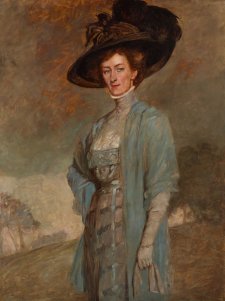
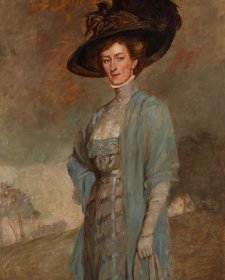
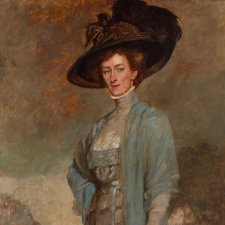
Jennifer Higgie uncovers the intriguing stories behind portraits of women by women in the National Portrait Gallery’s collection.
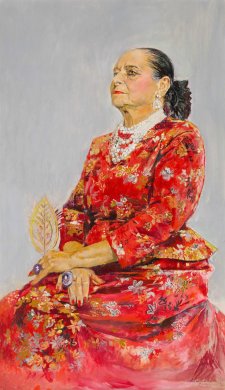
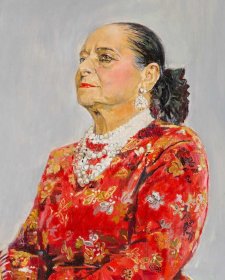
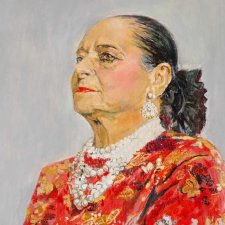
Well behaved women seldom make history, as the saying goes, and the National Portrait Gallery, consequently, is full of awesome Australian women who refused to conform to narrow ideas about their place and their worth.